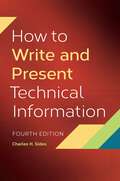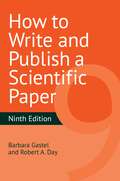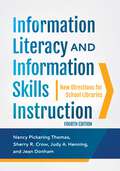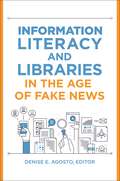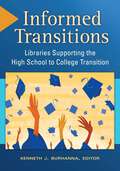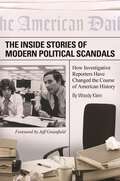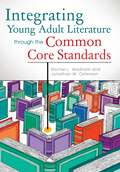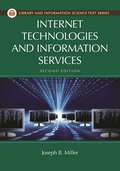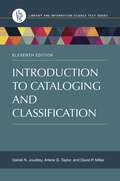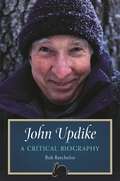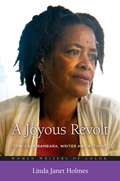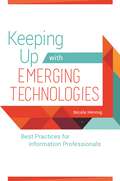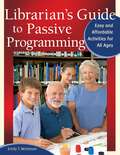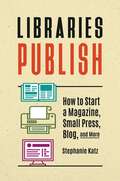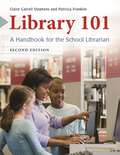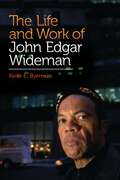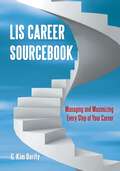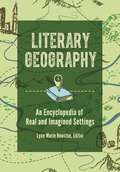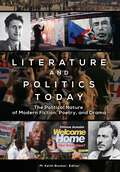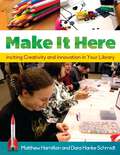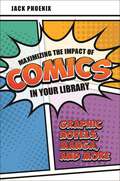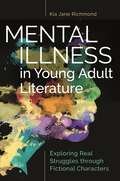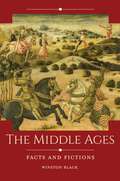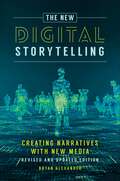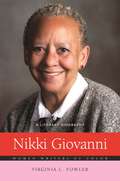- Table View
- List View
How to Write and Present Technical Information
by Charles H. SidesThoroughly updated to discuss the use of tools such as Skype and social media, this concise volume shows how effective communication—via written text and spoken presentations—can positively impact project management in professional environments.Professional communications are the "information product" of all organizations and businesses. Based on that premise, this book offers communications strategies that will benefit any organization that disseminates technical information in-house and/or to customers. The popular work provides easy-to-understand and apply guidelines for designing and writing effective technical documents, as well as other related communications. What makes this new edition especially valuable is that it maintains the quality of information that distinguished the previous editions, but is now updated to encompass current technology and trends, including today's prevalent communication tools such as social media.The book begins by looking at skills common to all technical writing and offering general advice on designing and writing reports. Next is a discussion of specific types of reports along with common problems and issues writers face. Finally, the work overviews other forms of communications such as professional presentations. The updated material also considers the growing importance of interviews and focus groups as information-gathering tools, the influence of visual rhetoric, and the use of technologies such as Skype and webinars.
How to Write and Publish a Scientific Paper
by Barbara Gastel Robert A. DayThoroughly updated throughout, this classic, practical text on how to write and publish a scientific paper takes its own advice to be "as clear and simple as possible.""The purpose of scientific writing," according to Barbara Gastel and Robert A. Day, "is to communicate new scientific findings. Science is simply too important to be communicated in anything other than words of certain meaning."This clear, beautifully written, and often funny text is a must-have for anyone who needs to communicate scientific information, whether they're writing for a professor, other scientists, or the general public. The thoughtfully revised 9th edition retains the most important material-including preparing text and graphics, publishing papers and other types of writing, and plenty of information on writing style-while adding up-to-date advice on copyright, presenting online, identifying authors, creating visual abstracts, and writing in English as a non-native language.A set of valuable appendixes provide ready reference, including words and expressions to avoid, SI prefixes, a list of helpful websites, and a glossary. Students and working scientists will want to keep How to Write and Publish a Scientific Paper at their desks and refer to it at every stage of writing and publication.
Information Literacy and Information Skills Instruction: New Directions for School Libraries
by Nancy Pickering Thomas Sherry R. Ph.D. Judy A. Henning Jean Donham Ph.D.Exploring the ways in which today's Internet-savvy young people view and use information to complete school assignments and make sense of everyday life, this new edition provides a review of the literature since 2010.The development of information literacy skills instruction can be traced from its basis in traditional reference services to its current growth as an instructional imperative for school librarians. Reviewing the scholarly research that supports best practices in the 21st-century school library, this book contains insights into improving instruction across content areas—drawn from the scholarly literatures of library and information studies, education, communication, psychology, and sociology—that will be useful to school, academic, and public librarians and LIS students.In this updated fourth edition, special attention is given to recent studies of information seeking in changing instructional environments made possible by the Internet and new technologies. This new edition also includes new chapters on everyday information seeking and motivation and a much-expanded chapter on Web 2.0. The new AASL standards are included and explored in the discussion. This book will appeal to LIS professors and students in school librarianship programs as well as to practicing school librarians.
Information Literacy and Libraries in the Age of Fake News
by Denise E. Agosto, EditorGoing beyond the fake news problem, this book tackles the broader issue of teaching library users of all types how to become more critical consumers and sharers of information.As a public, school, or academic librarian or educator, you can help library users to become more conscious and responsible consumers of information. As you read, you'll gain a better understanding and appreciation of the core concepts involved in promoting critical information literacy, such as information ethics, media literacy, and civic education. You'll also learn the history of fake news and come away with practical ideas in mind for strategies to apply in your library.Chapters contributed by leading experts in public, academic, and school library services are written in plain, everyday language that librarians and library school students can easily understand and relate to their own experiences as information users, especially their experiences in social media and other online venues where sharing false information takes only a click.
Informed Transitions: Libraries Supporting the High School to College Transition
by Kenneth J. Burhanna Toni Anaya Leslie Barton Kathleen Conley Paula Nespeca Deal Leanne Ellis Robert Farrell Anthony J. Fonseca Mitchell J. Fontenot Kim Garwood Julie A. Gedeon Matthew Harrick Laurie Hathman Rhonda Huisman Curtis L. Kendrick JaNae Kinikin Dale Lackeyram Jillian Brandt Maruskin Clarke Mathany Charlene Maxey-Harris Louis E. Mays Brian L. Mikesell Megan Oakleaf Kindra Orr Patricia L. Owen Anne Marie Perrault Peggy A. Pritchard Thomas L. Reinsfelder Debra Cox Rollins Sherri Savage Barbara F. Schloman Kathryn B. Seidel Jennifer Sigalet Ann Walker Smalley Ann Marie Smeraldi Ken W. Stewart Barbara K. Stripling LeAnn Suchy Teresa Tartaglione Jill E. Thompson Tammy J. Eschedor Voelker Meghann Suzanne Walk Kate ZoellnerHow can libraries and librarians across the educational continuum work together to support student transitions from high school to college, utilizing free or low-cost resources? This book supplies the answers.Informed Transitions: Libraries Supporting the High School to College Transition identifies the ways in which libraries and librarians can work together and create valuable resources that help students transition successfully to college—despite the challenges of increasing demand and diminishing resources.The book is organized into three sections: background, expectations, and skills; conversations and collaborations; and programs and resources. Section 1 establishes a foundational understanding of the libraries' role in supporting college transitions. Section 2 shares model conversations that move this work forward, stressing its collaborative nature. The third section highlights some well-established programs and resources that effectively support high school to college transitions. Practical information is provided throughout, pinpointing what high school students need to know to smoothly transition to college, spotlighting the expectations of college professors, and discussing audience-specific methods of working with students at the high school and college levels.
The Inside Stories of Modern Political Scandals: How Investigative Reporters Have Changed the Course of American History
by Woody KleinThis book examines ten major political scandals involving the White House in the past 50 years, revealing how the investigative reporters behind the stories uncovered the hidden truths.On numerous occasions, the dogged efforts of investigative journalists have led to a dissemination of information that had a direct effect on the course of American history—the Bay of Pigs fiasco, the Watergate scandal, "Monicagate" of the Clinton administration, and the Enron accounting scandal.The Inside Stories of Modern Political Scandals: How Investigative Reporters Have Changed the Course of American History features in-depth interviews with all living journalists responsible for revealing major political scandals involving the White House, including Bob Woodward and Carl Bernstein, the reporters responsible for bringing the Watergate scandal to the light of day. The author presents a fascinating view into the "story behind the story" regarding the ten most momentous, modern-day political scandals in America. Containing both anecdotes from the investigative reporters involved and specific examples from published articles, this text reveals the specific methods used by these award-winning journalists to successfully pursue their stories and earn their titles as watchdogs of our government, our military, and big business.
Integrating Young Adult Literature through the Common Core Standards
by Rachel L. Wadham Jon W. OstensonThis book advocates for a stronger role for young-adult literature in ELA classrooms, compellingly documenting how this body of work meets both the needs of adolescent students and the demands of the common core for complex texts and tasks.Integrating Young Adult Literature through the Common Core Standards provides a compelling template for teachers that uses young adult literature and inquiry learning to meet students' needs and the demands of the common core standards.The first part of the book addresses the widely adopted common core state standards by examining closely the standards' model of text complexity and demonstrating how young adult literature can fill the requirements of this model. The second part provides theoretical discussions and analysis of the standards as well as concrete applications of young adult literature within the classroom in order to give school professionals a comprehensive understanding of how young adult literature and the standards can work together. The book empowers schools and teachers to make intelligent, informed decisions about texts and instructional practices that benefit their students.Finally, the authors explore a powerful teaching approach that integrates current understandings about learning, young adult literature, and the common core standards in a way that will facilitate greater learning and understanding in English classrooms.
Internet Technologies and Information Services (Library and Information Science Text Series)
by Joseph B. MillerThe Internet has enabled the convergence of all things information-related. This book provides essential, foundational knowledge of the application of Internet and web technologies in the information and library professions.Internet Technologies and Information Services: Second Edition is a vital asset to students preparing for careers in library and information science and provides expanded coverage to important new developments while still covering Internet foundations. In addition to networking, the Internet, HTML, web design, web programming, XML, and web searching, this new edition covers additional topics such as cloud computing, content management systems, eBook technologies, mobile technologies and applications, relational database management systems (RDMS), open source software, and virtual private networking. It also provides information on virtualization and related systems, including desktop virtualization systems.With clear and simple explanations, the book helps students form a solid, basic IT knowledge that prepares them for more advanced studies in technology. It supplies an introductory history of the Internet and an examination of current trends with specific emphasis on how online information access affects the LIS fields. Author Joseph B. Miller, MSLS, explains Internet protocols and current broadband connectivity options; Internet security issues and steps to take to block threats; building the web with markup languages, programming, and content management systems; and elements of information access on the web: content formats, information retrieval, and Internet search.
Introduction to Cataloging and Classification (Library and Information Science Text Series)
by Daniel N. Joudrey Arlene G. Taylor David P. MillerA new edition of this best-selling textbook reintroduces the topic of library cataloging from a fresh, modern perspective.Not many books merit an eleventh edition, but this popular text does. Newly updated, Introduction to Cataloging and Classification provides an introduction to descriptive cataloging based on contemporary standards, explaining the basic tenets to readers without previous experience, as well as to those who merely want a better understanding of the process as it exists today. The text opens with the foundations of cataloging, then moves to specific details and subject matter such as Functional Requirements for Bibliographic Records (FRBR), Functional Requirements for Authority Data (FRAD), the International Cataloging Principles (ICP), and RDA. Unlike other texts, the book doesn't presume a close familiarity with the MARC bibliographic or authorities formats; ALA's Anglo-American Cataloging Rules, 2nd Edition, revised (AACR2R); or the International Standard Bibliographic Description (ISBD). Subject access to library materials is covered in sufficient depth to make the reader comfortable with the principles and practices of subject cataloging and classification. In addition, the book introduces MARC, BIBFRAME, and other approaches used to communicate and display bibliographic data. Discussions of formatting, presentation, and administrative issues complete the book; questions useful for review and study appear at the end of each chapter.
John Updike: A Critical Biography
by Bob BatchelorOne of the world's greatest writers, John Updike chronicled America for more than five decades. This book examines the essence of Updike's writing, propelling our understanding of his award-winning fiction, prose, and poetry.Widely considered "America's Man of Letters," John Updike is a prolific novelist and critic with an unprecedented range of work across more than 50 years. No author has ever written from the variety of vantages or spanned topics like Updike did. Despite being widely recognized as one of the nation's literary greats, scholars have largely ignored Updike's vast catalog of work outside the Rabbit tetralogy. This work provides the first detailed examination of Updike's body of criticism, poetry, and journalism, and shows how that work played a central role in transforming his novels. The book disputes the common misperception of Updike as merely a chronicler of suburban, middle-class America by focusing on his novels and stories that explore the wider world, from the groundbreaking The Coup (1978) to Terrorist (2006). Popular culture scholar Bob Batchelor asks readers to reassess Updike's career by tracing his transformation over half a century of writing.
A Joyous Revolt: Toni Cade Bambara, Writer and Activist (Women Writers of Color)
by Linda Janet HolmesAt long last—a book-length biography celebrates Toni Cade Bambara, a seminal literary, cultural, and political figure who was among the most widely read and frequently reviewed of the well-regarded black women writers to emerge in the 1970s.A Joyous Revolt: Toni Cade Bambara, Writer and Activist is the first-ever, full-length biography of a trailblazing artist who championed black women in her fiction as well as in her life. This incisive study provides a comprehensive treatment of Bambara's published and unpublished works, and it also documents her emerging vision of her role as an agent of change.The biography allows readers into the personal life of Bambara, offering personal insights into a woman with a strong public persona and friendships with other celebrated artists of her era. Perhaps most important for those seeking to understand and appreciate Bambara's legacy, it connects her oeuvre to the context of her experience and places all of her wide-ranging creative work in the context of her singular vision.
Keeping Up with Emerging Technologies: Best Practices for Information Professionals
by Nicole HennigThe acceleration of technological change demands that today's information professionals and educators not only be constantly acquiring new knowledge and skills, but also that they cultivate the ability to make sound judgments on which technologies to embrace.Today's librarians and information specialists know it's imperative that they keep up with new technologies. But not all technologies are equally important, either within the library setting or to library patrons. So how does one decide which ones to pursue and integrate into services? In the uphill battle to stay current with new and emerging technologies, deciding which ones to pursue and integrate into services is a major challenge. A secondary problem is simply finding the time to consider the question. Readers of Keeping Up with Emerging Technologies will learn all of the best practices and skills to keep up with new technologies and to analyze the ability of specific technologies to meet recognized user needs—all in this single source.You'll learn the best ways to gather information about new technologies and user needs, to evaluate and analyze information, to curate technology information for others, to set up experiments and evaluate the results, and to present your findings to persuade decision-makers. Written by the former head of user experience at MIT's library system, this guidebook serves information professionals, educators, education technology specialists, and anyone with "emerging technology" or "innovation" in their job titles. It will also be useful for library administrators and those who manage these positions as well as for students seeking a technology-oriented or curriculum-design career path in libraries.
Librarian's Guide to Passive Programming: Easy and Affordable Activities for All Ages
by Emily T. WichmanLearn the concept of passive programming and get started easily with plans for implementing a wide array of intergenerational programs in libraries with this professional primer.Libraries are an integral part of the community, a fact that can often be overlooked in today's world of home-based online research. Passive programs encourage patrons to linger—either in the library or on the library's website—and promote a connection to the library's collections, its services, and the community.Librarian's Guide to Passive Programming: Easy and Affordable Activities for All Ages presents plans for 32 passive programs designed to capture the attention of library patrons. Each chapter—which contains programs grouped thematically—details the steps necessary to reproduce the programs, and includes supporting handouts, activities, and photographs. This helpful guide also examines what passive programming is, why passive programming is relevant, and offers strategies across all aspects of its implementation—from developing program ideas to evaluating program success.
Libraries Publish: How to Start a Magazine, Small Press, Blog, and More
by Stephanie KatzIn this book, author Stephanie Katz, founding editor of the award-winning literary journal 805 Lit + Art, shares practical tools and advice for starting successful creative publishing projects.Publishing benefits libraries by providing high-quality content to patrons, showcasing local writers and faculty, and creating buzz for the library. These endeavors can be launched at any type and size of library, often for little to no cost. Libraries Publish teaches libraries how to publish literary magazines, book review blogs, local anthologies, picture books, library professional journals, and even novels. You'll learn how to run a writing contest or writer-in-residence program, form community partnerships with other literary organizations, find funding, navigate legal considerations, market your publication, and more. Each chapter contains detailed information on how to start your project, including comprehensive checklists, recommendations for free software, and legal considerations. Social media strategies as well as tips for facilitating student or teen-run projects are also covered. If your library wants to start a publishing project, this book will be your go-to resource!
Library 101: A Handbook for the School Librarian
by Claire Gatrell Stephens Patricia FranklinThis professional primer provides the blueprint to help you create a school library program, covering all aspects of library management such as budgeting, eBook use, purchasing, and teacher collaboration. Advice and strategies from experts in the field will help you master collection development, library administration, recruitment, and staffing.This handbook is the perfect introduction to school library management for both novice and seasoned professionals. The authors—both experienced school librarians—provide basic guidelines for overseeing an effective library program, practical examples that can be used to implement quality lessons, comprehensive coverage of key topics including daily tasks and human resource management, and ideas for the future of school library management. The provided strategies make setting up and running a program easy for professionals at any level. The second edition includes updated information on the latest trends, terminology, and technologies current in the field. The book is organized into three sections: focusing on daily operations; your role as a teacher collaborator and visionary; and methods for managing a collection. Included resource lists, sidebars, charts, and pictures offer tips and ideas for successfully implementing your plans.
The Life and Work of John Edgar Wideman
by Keith E. ByermanChallenging. Successful. Controversial. All terms used to accurately describe African American novelist and autobiographer John Edgar Wideman. This book examines his life and work—and the connections between them.The Life and Work of John Edgar Wideman is ideal for readers who might not be familiar with Wideman's work or those who may have been intimidated by descriptions of his writings. Through its coverage of Wideman's life from several generations back to the present and explanations of how Wideman makes use of life experiences, this book breaks down barriers for new readers and enables them to better relate and connect to his writing. Author Keith E. Byerman discusses Wideman's book-length works of fiction and nonfiction, as well as some of his shorter, journalistic pieces. The book emphasizes how Wideman integrates family and personal experience into what is typically labeled postmodern writing, and explains how he has evolved as a public intellectual who supplies shrewd commentary on subjects such as the prison system, terrorism, and the role of sports in American society.
LIS Career Sourcebook: Managing and Maximizing Every Step of Your Career
by G. Kim DorityA must-have guide of professional development resources for library staff at every phase of their career—from those just entering the field, to paraprofessionals building a career trajectory, to seasoned librarians looking to explore additional career options.Thousands of students graduate with a Master of Library and Information Science degree every year. Unfortunately, budget cuts at libraries diminish available job opportunities and prompt administrators to hire less qualified—and less expensive—professionals. However, armed with the right information, library science professionals can successfully build and sustain a resilient library and information science (LIS) career inside—or outside—the traditional library setting.LIS Career Sourcebook: Managing and Maximizing Every Step of Your Career provides a chapter-by-chapter overview of key career stages and strategies, and identifies for each the best information resources to help readers develop a successful LIS career. The author lays out the typical stages that workers are likely to encounter as they move through their professional life, highlighting important issues associated with each stage and providing insights and resources for making smart career choices along the way. Covering the entire career lifespan from entry level to retirement, the resources cited will help readers make informed choices about career options, professional development, and personal career satisfaction.
Literary Geography: An Encyclopedia of Real and Imagined Settings
by Lynn Marie HoustonThis reference investigates the role of landscape in popular works and in doing so explores the time in which they were written.Literary Geography: An Encyclopedia of Real and Imagined Settings is an authoritative guide for students, teachers, and avid readers who seek to understand the importance of setting in interpreting works of literature, including poetry. By examining how authors and poets shaped their literary landscapes in such works as The Great Gatsby and Nineteen Eighty-Four, readers will discover historical, political, and cultural context hidden within the words of their favorite reads. The alphabetically arranged entries provide easy access to analysis of some of the most well-known and frequently assigned pieces of literature and poetry. Entries begin with a brief introduction to the featured piece of literature and then answer the questions: "How is literary landscape used to shape the story?"; "How is the literary landscape imbued with the geographical, political, cultural, and historical context of the author's contemporary world, whether purposeful or not?" Pop-up boxes provide quotes about literary landscapes throughout the book, and an appendix takes a brief look at the places writers congregated and that inspired them. A comprehensive scholarly bibliography of secondary sources pertaining to mapping, physical and cultural geography, ecocriticism, and the role of nature in literature rounds out the work.
Literature and Politics Today: The Political Nature of Modern Fiction, Poetry, and Drama
by M. Keith Booker, EditorFocusing on the intersection of literature and politics since the beginning of the 20th century, this book examines authors, historical figures, major literary and political works, national literatures, and literary movements to reveal the intrinsic links between literature and history.Literary works have often engaged political issues, and many political writings give close attention to literary concerns. This encyclopedia explores the complex relationship between literature and politics through detailed entries written by expert contributors on authors, historical figures, major literary and political works, national literatures, and literary movements, covering specific themes, concepts, and genres related to literature and politics from the 20th century to the present. The work covers cover authors that include Margaret Atwood, James Baldwin, Philip K. Dick, W.E.B. Du Bois, William Faulkner, Ernest Hemingway, Jack London, Toni Morrison, George Orwell, John Steinbeck, and Virginia Woolf, just to mention a few.International in scope, Literature and Politics Today: The Political Nature of Modern Fiction, Poetry, and Drama covers writing ranging from the beginning of the 20th century to the present, with special emphasis on works written in English. The content of the some 150 alphabetically arranged entries is ideal for high school students working on assignments involving literature to explore such current yet historically ongoing social issues as censorship and propaganda. This book is appropriate for public libraries where it will serve to support student research and to help general readers learn more about enduring political concerns through literary works. Academic libraries will find this reference a valuable guide for undergraduates studying literature, history, political science, law, and other disciplines.
Make It Here: Inciting Creativity and Innovation in Your Library
by Matthew Hamilton Dara Hanke SchmidtThis is an ideal resource for joining the maker movement, no matter the size of your public library or resource level.Libraries of all sizes and resource levels are finding ways to support community innovation and creativity through maker programming—and successful programs don't require dedicating an entire area of the library to makerspace activities or sophisticated technologies such as 3D printers. Make It Here: Inciting Creativity and Innovation in Your Library provides a complete, step-by-step guide for starting a makerspace program at your library and follows through with instructions for operation and building on your success.This book takes you step-by-step through starting your maker program—from finding the right "makerspace mix," making a plan, and working with staff to establishing funding and support, launching your makerspace, and evaluating and refining your programs. The authors provide guidance based on their personal experiences in creating and developing maker programs in their libraries as well as feedback and lessons learned from library makers across the country. You'll see how easy it can be to bring their ideas to life in ways that will empower your community, and be encouraged to be bold and think outside of the box when imagining the possibilities.
Maximizing the Impact of Comics in Your Library: Graphic Novels, Manga, and More
by Jack PhoenixThis unique guide offers fresh insights on how graphic novels and comics differ from traditional books and require different treatment in the library—from purchasing, shelving, and cataloging to readers' advisory services, programs, and curriculum.Challenging librarians to rethink some of their traditional practices, Maximizing the Impact of Comics in Your Library provides creative and proven solutions for libraries of all types that want to get comics into the hands of fans and promote readership. The author describes how libraries would benefit from an in-house classification system and organization that accounts for both publishers and series. In addition, acquiring comics can often be tricky due to renumbering of series, reboots, shifting creative teams, and more—this book shows you how to work around those obstacles. Shelving and displays that reflect comic readers' browsing habits, creative programs that boost circulation of comics and graphic novels, and how comics can play a vital role in educational institutions are also covered.
Mental Illness in Young Adult Literature: Exploring Real Struggles through Fictional Characters
by Kia Jane RichmondThis book explores how mental illness is portrayed in 21st-century young adult fiction and how selected works can help teachers, librarians, and mental health professionals to more effectively address the needs of students combating mental illness.Mental Illness in Young Adult Literature: Exploring Real Struggles through Fictional Characters highlights American young adult literature published since the year 2000 that features characters grappling with mental illness. Chapters focus on mental disorders identified by the most recent Diagnostic and Statistical Manual of Mental Disorders (DSM-5), including anxiety, depression, bipolar disorder, schizophrenia, ADHD, and OCD. Each chapter begins with a description of a mental illness that includes its prevalence, demographic trends, symptoms, related disorders, and treatment options before examining a selection of young adult texts in depth. Analysis of the texts explores how a mental illness manifests for a particular character, how that character perceives him- or herself and is perceived by others, and what treatment or support he or she receives. The connections between mental illness and race, ethnicity, gender, sexuality, and identity are examined, and relevant research from education, psychology, and adolescent health is thoroughly integrated. Each chapter also provides a list of additional readings. An appendix offers strategies for integrating young adult literature into health curricula and other programs.
The Middle Ages: Facts and Fictions (Historical Facts and Fictions)
by Winston BlackThis book guides readers through 10 pervasive fictions about medieval history, provides them with the sources and analytical tools to critique those fictions, and identifies what really happened in the Middle Ages.This book is the first to present fictions about the medieval world to serious students of history. Instead of merely listing myths and stating they are wrong, this volume promotes critical historical analysis of those myths and how they came to be. Each of the ten chapters outlines a pervasive modern myth about medieval European history, describing "What People Think Happened" and "What Really Happened," and illustrating both trends with primary source documents.The book demonstrates that historical fictions also have a history, and that while we need to replace those fictions with facts about the medieval past, we can also benefit from understanding how a fiction about the Middle Ages developed and what that says about our modern perspectives on the past. Through this innovative presentation, readers are introduced to a wide range of sources, from Roman imperial perspectives on the "Fall of Rome" to songs of chivalry and chronicles of the Crusades, scientific treatises on the shape of the Earth and the creation of the universe and early modern stories and textbooks that developed or perpetuated historical myths.
The New Digital Storytelling: Creating Narratives with New Media--Revised and Updated Edition
by Bryan AlexanderNewly revised and updated, this is the essential guide to state-of-the-art digital storytelling for audiences, creators, and teachers.Written for everyone interested in the communication potential of digital media, including educators, marketers, communication professionals, and community activists, this is the ultimate guide to harnessing technology for storytelling. No other book covers the digital storytelling movement as thoroughly as this updated second edition of a popular work, nor does any incorporate as many technologies, from video to augmented reality, mobile devices to virtual reality.The book combines history, analysis, and practical guidance about digital storytelling. It begins with a history that encompasses an exploration of storytelling itself, as well as a description of narratives using digital tools from the 1980s through 2000. From there, the author dives into modern digital storytelling, offering analysis and guidance regarding the use of digital video, podcasting, social media, gaming, mobile devices, and virtual and augmented reality. The work concludes with practical advice about how to create and share digital stories using the most current tools so even the new would-be storyteller can create their first digital narrative. Of course, the second edition is updated to take into account the many ways the field has advanced since the original book appeared. With many new examples of digital stories, this edition's evidence base is current and fresh. New or transformed technologies are also addressed, including virtual reality; mobile devices that have become mainstream tools for creating, sharing, and experiencing digital stories; and the wide variety of new storytelling apps and services.
Nikki Giovanni: A Literary Biography (Women Writers of Color)
by Virginia C. FowlerThis book offers a comprehensive examination of the life and work of Nikki Giovanni, one of the most prolific and well-known poets to emerge during the Black Arts Movement.Nikki Giovanni: A Literary Biography focuses on one of the most widely read poets to emerge from the Black Arts Movement, providing a thorough examination of Giovanni's life and work, from her earliest volume of poetry, Black Feeling Black Talk, to the recent Bicycles. The book addresses Giovanni's preoccupation with historical themes and the past, and demonstrates the pervasiveness of music in Giovanni's poetry.Drawing on extensive interviews with Giovanni's friends and family, this book offers biographical information not previously available in other publications. It references material from Giovanni's prose works to illuminate and contextualize the analysis of her poetry, examining its highly allusive and topical nature. The book also shows the intersections of Giovanni's biography and the public history of the United States from the 1960s to the present, making it of interest to general readers as well as those studying American and African-American poetry or black feminism.
